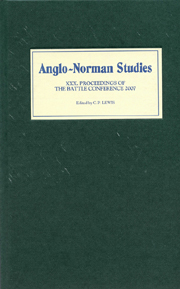Book contents
- Frontmatter
- Contents
- LIST OF ILLUSTRATIONS, MAPS, AND TABLES
- EDITOR'S PREFACE
- ABBREVIATIONS
- The Normans in Welsh History (R. Allen Brown Memorial Lecture)
- William Marshal, Lancelot, and Arthur: Chivalry and Kingship
- Grades of Ordination and Clerical Careers, c. 900–c. 1200
- Evesham J and Evesham L: Two Early Twelfth-Century Manorial Surveys
- Aspects of Church Reform in Wales, c. 1093–c. 1223
- Lay Charters and the Acta of Henry II
- Reinventing Normans as Crusaders? Ralph of Caen's Gesta Tancredi
- Kings, Lords, Charters, and the Political Culture of Twelfth-Century Wales
- Identifying the Warrior on the Pre-Heraldic Battlefield
- St Nicholas the Pilgrim and the City of Trani between Greeks and Normans, c. 1090–c. 1140
- The ‘Resurgence’ of Powys in the Late Eleventh and Early Twelfth Centuries
- Interpreter Families and Anglo-Welsh Relations in the Shropshire-Powys Marches in the Twelfth Century
- A Taste for the Antique? Henry of Blois and the Arts
Evesham J and Evesham L: Two Early Twelfth-Century Manorial Surveys
Published online by Cambridge University Press: 12 September 2012
- Frontmatter
- Contents
- LIST OF ILLUSTRATIONS, MAPS, AND TABLES
- EDITOR'S PREFACE
- ABBREVIATIONS
- The Normans in Welsh History (R. Allen Brown Memorial Lecture)
- William Marshal, Lancelot, and Arthur: Chivalry and Kingship
- Grades of Ordination and Clerical Careers, c. 900–c. 1200
- Evesham J and Evesham L: Two Early Twelfth-Century Manorial Surveys
- Aspects of Church Reform in Wales, c. 1093–c. 1223
- Lay Charters and the Acta of Henry II
- Reinventing Normans as Crusaders? Ralph of Caen's Gesta Tancredi
- Kings, Lords, Charters, and the Political Culture of Twelfth-Century Wales
- Identifying the Warrior on the Pre-Heraldic Battlefield
- St Nicholas the Pilgrim and the City of Trani between Greeks and Normans, c. 1090–c. 1140
- The ‘Resurgence’ of Powys in the Late Eleventh and Early Twelfth Centuries
- Interpreter Families and Anglo-Welsh Relations in the Shropshire-Powys Marches in the Twelfth Century
- A Taste for the Antique? Henry of Blois and the Arts
Summary
Traditionally the history of Evesham abbey begins in the year 701 when Æthelræd, king of the Mercians (674–704), granted to Ecgwine, third bishop of the Hwicce (693–704), the place æt Hamme (Hethomme). Out of a mass of pious legend, uncertain tradition, fraudulent invention, and ill-recorded fact, this is probably all that will ever be known beyond reasonable doubt. This hamm was a piece of land within the great loop of the river Avon that was later to contain the church, conventual buildings, and medieval town. According to the twelfth-century historian William of Malmesbury, there may have been a small British church on this site, a possibility unrecorded elsewhere. The historical core of the jungle of fact and fiction, legend and tradition that makes up the purported early Evesham documentation is likely to have been of the utmost simplicity. Desirous of founding a monastery, Ecgwine, bishop of the Hwicce, secured a site and adequate endowment between 701 and 709, when the new buildings were consecrated. For the remainder of his life Ecgwine may have spent much of his time at Evesham in semi-retirement, until his death on 30 December 717. Over the centuries, and especially during the eleventh century, the character of the founder was magnified and sanctified, the size of the initial endowment was grossly exaggerated, and papal privileges were added for good measure. The Evesham known to Ecgwine was no doubt a humble establishment, with a compact block of territory on both banks of the Avon and an outlier, Ombersley, in the Severn valley north of Worcester.
- Type
- Chapter
- Information
- Anglo-Norman Studies 30Proceedings of the Battle Conference 2007, pp. 62 - 84Publisher: Boydell & BrewerPrint publication year: 2008



